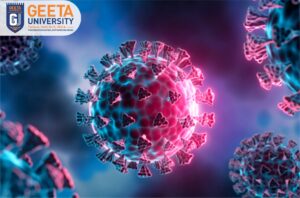Forensic Odontology: Investigating Beyond the Bite
Uncategorized- April 30, 2024
- Geeta University

Forensic odontology, a fascinating field at the intersection of dentistry and law enforcement, plays a crucial role in solving crimes and identifying individuals when traditional methods fall short. With its roots dating back to ancient civilizations like the Egyptians and the Romans, forensic odontology has evolved into a sophisticated science employing dental evidence to assist in criminal investigations, disaster victim identification, and even historical reconstructions.
At its core, forensic odontology leverages the unique characteristics of teeth to establish the identity of individuals. Dental records, including X-rays, photographs, and dental charts, serve as invaluable tools for comparison when remains are found at crime scenes or mass disasters. Through meticulous examination and analysis, forensic odontologists can match dental records to the dentition of an unidentified victim, providing crucial information to law enforcement agencies and families seeking closure.
One of the primary applications of forensic odontology is in cases of mass disasters, such as plane crashes, natural disasters, or terrorist attacks. In these tragic events, traditional methods of identification may be challenging due to the condition of the remains. However, teeth are remarkably resilient to extreme conditions like fire, decomposition, or trauma, often surviving when other body parts do not. Forensic odontologists can extract vital information from dental remains, offering a means of identification even in the most challenging circumstances.
Moreover, forensic odontology plays a pivotal role in criminal investigations by linking suspects to crime scenes or victims. Bite mark analysis, though controversial due to its subjective nature, can provide valuable evidence in cases of assault, sexual abuse, or homicide. By comparing bite marks on victims to the dental impressions of suspects, forensic odontologists can establish a connection between the perpetrator and the crime, potentially aiding in convictions and ensuring justice is served.
The field of forensic odontology is not without its challenges and limitations. Despite advancements in technology and methodology, there are inherent complexities in dental identification, particularly when dealing with fragmented or poorly preserved remains. Additionally, the subjective nature of bite mark analysis has led to criticisms regarding its reliability and accuracy, prompting calls for more rigorous standards and protocols within the discipline. Nevertheless, forensic odontology continues to evolve through research, collaboration, and the integration of new technologies. Emerging techniques, such as 3D imaging, computerized dental databases, and dental DNA analysis, hold promise for enhancing the accuracy and efficiency of dental identification processes. Furthermore, interdisciplinary collaboration between forensic odontologists, anthropologists, geneticists, and law enforcement professionals ensures a comprehensive approach to forensic investigations, maximizing the potential for successful outcomes.

Admission Open 2024-2025
For Your bright Future
History of Forensic Odontology:
The history of forensic odontology is rich and spans thousands of years, with its origins rooted in ancient civilizations. One of the earliest recorded uses of dental evidence dates back to ancient Egypt, where dental abnormalities were documented on clay tablets for identification purposes. Similarly, in ancient Rome, the practice of using dental records to establish identity was noted in legal texts.
However, the formalization of forensic odontology as a distinct discipline began to take shape in the 19th century. In 1776, Paul Revere, better known for his role in the American Revolutionary War, is believed to have made one of the first recorded forensic dental identifications when he identified the body of a soldier killed in the Battle of Bunker Hill by examining his dental prosthetics. This event marked a significant milestone in the recognition of dentistry’s potential in forensic investigations.
The 20th century witnessed significant advancements in forensic odontology, spurred by technological innovations and scientific discoveries. In 1901, the American dentist Dr. Oscar Amoëdo published one of the earliest papers on dental identification, outlining the principles of using dental records for forensic purposes. Subsequently, the field gained momentum during World War II when forensic odontologists played a crucial role in identifying soldiers killed in combat by examining their dental remains. One of the most notable milestones in the history of forensic odontology occurred in 1970 with the establishment of the American Board of Forensic Odontology (ABFO). This organization set standards for forensic odontologists and promoted research and education in the field, solidifying its status as a legitimate branch of forensic science. Throughout the latter half of the 20th century and into the 21st century, forensic odontology continued to evolve, driven by advancements in technology and interdisciplinary collaboration. The introduction of dental imaging techniques such as X-rays, CT scans, and dental photography revolutionized the field, allowing for more precise analysis and identification of dental remains.
Application of Odontology in Forensic Science:
- Identification of Human Remains: Dental records, including dental X-rays, charts, and photographs, are often used to identify individuals when other means (such as fingerprints) are not available. Dentition is unique to each individual, and comparisons between ante-mortem (before death) and post-mortem (after death) dental records can establish positive identifications.
- Age Estimation: Dental development and eruption patterns can be used to estimate the age of both living and deceased individuals. This information is particularly valuable in cases involving unidentified remains, missing persons, or determining the age of minors in legal contexts.
- Bite Mark Analysis: Forensic odontologists analyze bite marks left on victims or objects at crime scenes. These analyses can provide valuable evidence in cases of assault, sexual assault, child abuse, or even in cases involving animals. Through comparisons with dental impressions of suspects or potential perpetrators, bite marks can contribute to identifying the responsible individual.
- Mass Disaster Victim Identification: In cases of mass disasters, such as plane crashes or natural disasters, where conventional means of identification may be challenging, forensic odontology can play a pivotal role. Dental records and comparative analysis help identify victims, providing closure to families and aiding in the investigative process.
- Human Rights Investigations: Forensic odontology is often employed in investigations of human rights violations, such as mass graves resulting from conflicts or genocides. Dental evidence can help identify victims and perpetrators, serving as crucial evidence in legal proceedings.
- Expert Testimony: Forensic odontologists may be called upon to provide expert testimony in court proceedings. They can explain dental evidence, methodologies used in analysis, and the significance of findings to judges and juries.
- Disaster Victim Recovery: Forensic odontologists are frequently involved in disaster victim recovery efforts, working alongside other forensic experts, law enforcement agencies, and disaster response teams to identify victims and facilitate their return to their families for proper burial or cremation.
- Criminal Investigations: Forensic odontology contributes to criminal investigations by providing evidence that can link suspects to crime scenes or victims. This includes analyzing dental evidence found at crime scenes, such as broken teeth or dental prostheses, and comparing them with dental records of suspects or victims.
Tools and techniques used in Forensic Odontology:
Forensic anthropology involves the application of physical anthropology and osteology principles to legal contexts. Here are some tools and techniques commonly used in forensic anthropology:
1. Skeletal Analysis: Forensic anthropologists examine skeletal remains to determine various biological characteristics of the individual, including age at death, sex, ancestry, stature, and individualizing features such as unique skeletal traits or pathologies.
2. Osteometric Analysis: This involves the measurement of skeletal elements to estimate an individual’s stature, age, and sex. Measurements are taken using calipers, osteometric boards, and other specialized tools.
3. Dental Analysis: Forensic anthropologists may examine dental remains to determine characteristics such as dental age, dental pathology, and dental morphology. Dental records can also be compared with the dentition of unidentified individuals for identification purposes.
4. Taphonomic Analysis: Taphonomy refers to the study of the processes that affect organisms after death. Forensic anthropologists analyze the state of skeletal remains to determine factors such as post-mortem interval, cause of death, and whether any post-mortem trauma or modifications have occurred.
5. Cranial Reconstruction: In cases where only partial skeletal remains are recovered, forensic anthropologists may reconstruct the missing parts of the skull using methods such as clay or computer-assisted facial reconstruction techniques.
6. DNA Analysis: While not exclusive to forensic anthropology, DNA analysis is often employed to confirm the identity of skeletal remains or to establish familial relationships in cases where traditional methods of identification are not feasible.
7. Radiography: X-ray imaging helps in assessing skeletal trauma, pathological conditions, and age estimation. X-rays can reveal fractures, bullet trajectories, and other important details that aid in the investigation.
8. Photography: Photographs are taken during all stages of examination, including in situ documentation of the remains, close-up images of specific features, and overall views of the skeleton. Photography provides a permanent record for analysis and documentation.
9. Facial Reconstruction: In cases where facial features are important for identification, forensic anthropologists may create facial reconstructions using clay, computer software, or other methods based on the morphology of the skull.
10. Isotopic Analysis: Isotopic analysis of bone or dental samples can provide information about the individual’s geographic origin, diet, and lifestyle, which may aid in identification and reconstruction of the individual’s life history.
11. Microscopy and Histology: Microscopic examination of bone tissue and histological analysis can reveal details about bone growth, development, and pathology, providing additional insights into the individual’s life history and cause of death.
Recent advancement in Forensic Odontology:
Recent advancements in forensic odontology have propelled the field into a new era of precision, efficiency, and reliability, significantly enhancing its contributions to legal investigations and justice systems worldwide. One of the most groundbreaking developments in recent years is the widespread adoption of digital technologies, which have revolutionized the way dental records are analyzed and compared. High-resolution imaging techniques, such as cone-beam computed tomography (CBCT) and intraoral scanning, provide forensic odontologists with detailed three-dimensional representations of dental structures, allowing for more accurate and comprehensive examinations than ever before. These digital tools facilitate the precise matching of ante-mortem and post-mortem dental records, enabling rapid and reliable identification of individuals in cases of mass disasters, missing persons, and criminal investigations. Moreover, advancements in computer-aided design (CAD) and forensic dental software have streamlined the process of dental record analysis, automating tedious tasks and reducing the risk of human error. Sophisticated algorithms and pattern recognition systems can now assist forensic experts in identifying unique dental features, such as dental restorations, anomalies, and occlusal patterns, with unprecedented speed and accuracy. This not only expedites the identification process but also enhances its reliability, ensuring that potential matches are thoroughly evaluated and verified.
In addition to digital innovations, recent years have witnessed significant progress in the field of DNA analysis, particularly concerning its application to dental materials. Traditionally, DNA extraction from teeth has been challenging due to the dense mineralized structure of dental tissues. However, advancements in extraction techniques and the refinement of molecular biology methods have overcome many of these obstacles, enabling the successful retrieval of DNA from sources such as dentin, pulp, and cementum. This breakthrough has vastly expanded the potential for positive identifications in cases where traditional dental records are unavailable or inconclusive, providing forensic investigators with an invaluable tool for resolving complex legal cases. Furthermore, recent research efforts have focused on improving the reliability and validity of bite mark analysis, an area of forensic odontology that has historically been subject to controversy and skepticism. Through interdisciplinary collaboration with experts in biomechanics, dermatology, and forensic pathology, forensic odontologists have developed innovative techniques for bite mark documentation, analysis, and interpretation. Advanced imaging modalities, such as digital photography, 3D scanning, and photogrammetry, allow for the precise capture and measurement of bite mark patterns, while biomechanical modeling and computer simulations provide insights into the dynamics of bite mark formation and variability. These multidisciplinary approaches not only enhance the scientific rigor of bite mark analysis but also increase its probative value as admissible evidence in legal proceedings.
Conclusion
In conclusion, recent advancements in forensic odontology have propelled the field forward, equipping forensic professionals with state-of-the-art tools and techniques to address the complex challenges of modern legal investigations. From digital imaging and DNA analysis to bite mark analysis and beyond, these advancements have revolutionized the practice of forensic odontology, enhancing its accuracy, efficiency, and reliability in the pursuit of justice. As technology continues to evolve and interdisciplinary collaboration flourishes, the future of forensic odontology holds immense promise for further advancements and innovations in the service of truth and justice.
Tags
Related Posts

Education trends after Covid 19 – Geeta University
The COVID 19 pandemic flipped the world’s education system upside down this year, causing a significant shift in how pupils learn and teachers teach. Education Trends after Covid 19 The COVID 19 pandemic flipped the world’s education system upside down

The future of Cryptocurrency in India – Geeta University
Gartner, leading research and consulting company, had predicted that the banking industry would receive $ 1 billion in business value in the use of blockchain Crypto currencies by 2022. The Future of Cryptocurrency in India Gartner, leading research and consulting

To be a Civil Engineer one must know – Geeta University
Civil engineering is in high demand for work. Working in this field requires very clear skills. It is not easy to find a great civil engineer and the best are richly rewarded. To Be a Civil Engineer one must know
